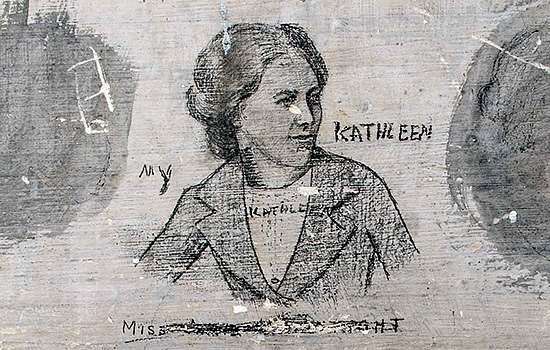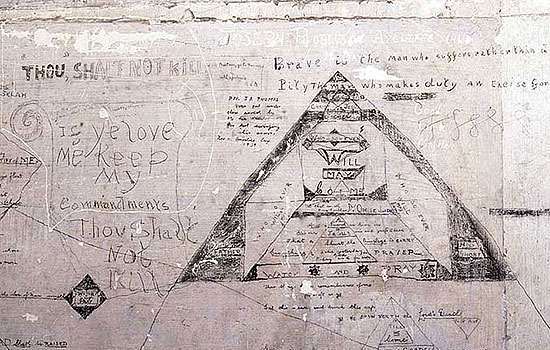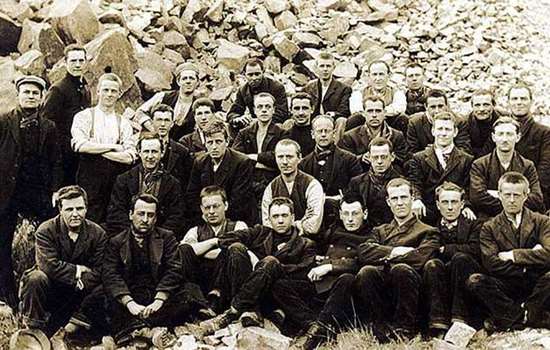A Fragile Record
If the graffiti had been written on paper, perhaps in personal letters or diaries, they would now be packaged in acid-free tissue, kept in a climate-controlled archive and handled by curators wearing white gloves. But conditions in the cell block could hardly be more different. The inscriptions are written on the transitory lime-washed walls of a late 19th-century building. Rainwater has penetrated the building fabric through fault lines in the roof and walls, causing a damaging level of moisture within the building.
Lime wash is a fragile, temporary material. Highly reactive to change, its stability and therefore its survival depend on the environment around it. The layers of lime wash and the wall plaster they are painted on contain salts that react to moisture. As moisture levels rise and fall, the salts first liquefy and then crystallise, a process of contraction and expansion that fragments the structure of the lime wash, breaking its bond with the render behind.
The result is a powdering and flaking of the surfaces, and a loss of the graffiti.
Read more about the GraffitiThe Power of Breath
Even our breath can impact on the graffiti. Within just a few minutes, a group of people within a single cell breathing warm, moist air into the space can significantly change the overall environment. A hand put out to steady yourself can dislodge lime-wash flakes. If a shoulder bag scuffs the wall, it can leave a line of loss in its wake.
Since 2014 conservation scientists from the Buildings Conservation and Research Team at Historic England have been establishing a picture of the building’s environment. They have recorded humidity and temperature levels inside the cells and moisture content within the walls, and tracked how these are affected by weather conditions and people visiting the cells. Analysis of the make-up of the walls and lime wash has determined the presence of salts, and how these react to their environment.
Keeping a record
Over the years, we have built up an in-depth record of the building. Laser scanning and high resolution photography, commissioned by Historic England’s Geospatial Imaging team, have given us accurate and detailed survey data. We have compared recent photographs with others taken in the 1990s to establish the extent and focus of decay in the intervening years. Some trial areas of wall have been repeatedly laser scanned to track any fractional movement in the lime wash.
Fixing the Roof, Sealing the Walls
The conservation project aims to gradually reduce the amount of moisture entering the cell block to achieve a much more stable internal environment. Phase one of the work is now complete.
Investigation revealed that there had been several attempts across the 20th century stop water leaking through the roof. We have now removed some of these early works and applied a self-adhesive liquid membrane to seal the whole area. New drainage channels have been created to carry surface water away quickly.
At the same time 20th-century cement pointing has been removed from the outer walls. Cement pointing is incredibly hard but it can hide microscopic cracks that allow moisture to get into the walls. Once inside the moisture finds it easier to escape through the softer internal render.
Cutting out such hard pointing was a potential problem in itself as vibration could dislodge precarious lime-wash inside. Careful study was made of the least aggressive techniques, with the use of hand tools and specific drills proving the least threatening techniques.
Re-securing the archive
Every three months specialists in the conservation of painted surfaces visit the cell block. There are a number of areas that they monitor on each visit as reference points to help understand how quickly, or slowly, the lime-wash is deteriorating.
Specialists also carry emergency treatment of failing areas using a lime solution to gently ease flaking material back onto the wall. It is painstaking work, but it ensures we lose as little as possible during the period when the building is drying out.
Checking Progress
The cell block is festooned with wires and gadgets capturing all sorts of data about the building’s environment. How much water is in the walls, what is the relative humidity (RH) and temperature in the air, how does this change as the external climate changes?
Since we finished the physical works in March 2017 we have been watching the data to see how the building is responding. Thankfully the picture shows a steady drying out across the building. Liquid water within the walls has dropped significantly suggesting the roof and wall works have been successful. RH levels remain high but are beginning to fall, mirroring the changes observed within the walls. We need to watch this carefully until the spring of 2019 to be certain of success.
Public Access
For the past 20 years we have strictly limited access to the cells. As we have looked for ways of solving the conservation challenges, we have done all we can to protect the graffiti.
The work being carried out between 2016 and 2019, with the support of the Heritage Lottery Fund, should significantly improve the environment within the building. If we can stabilise the surfaces on which the graffiti are written, we will be able to give controlled public access to the spaces for the very first time.



